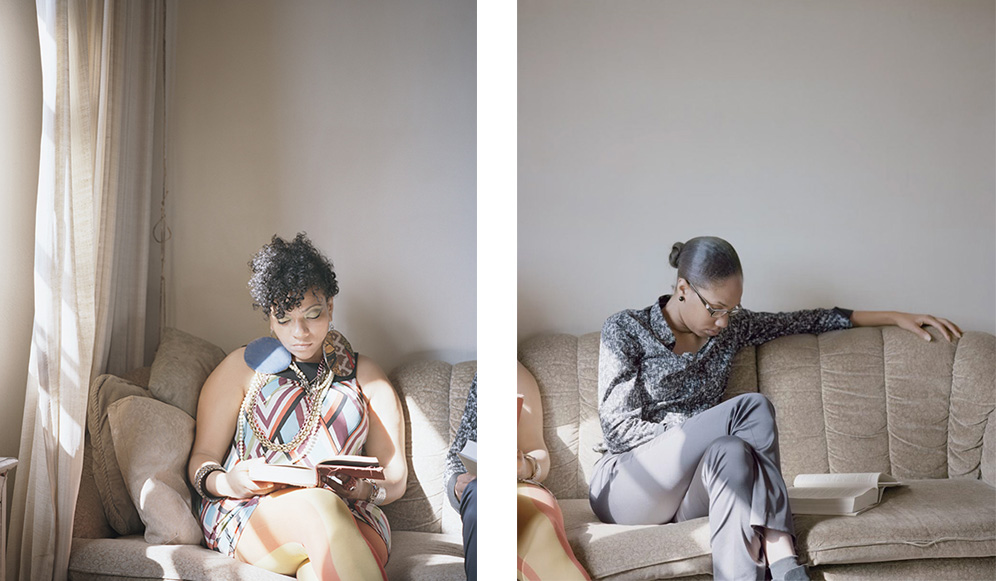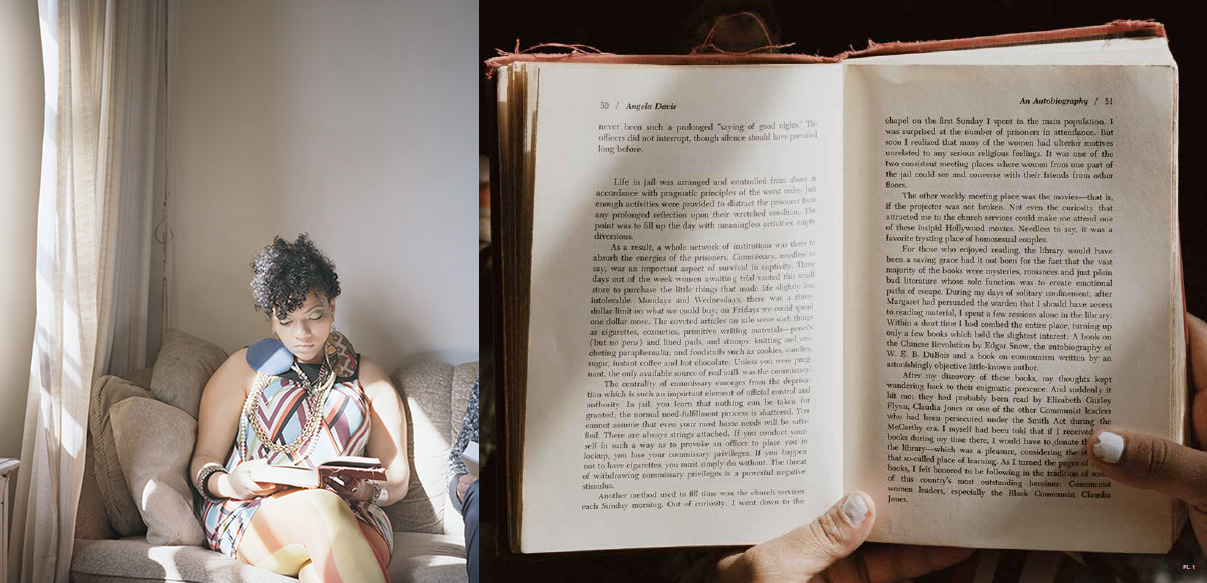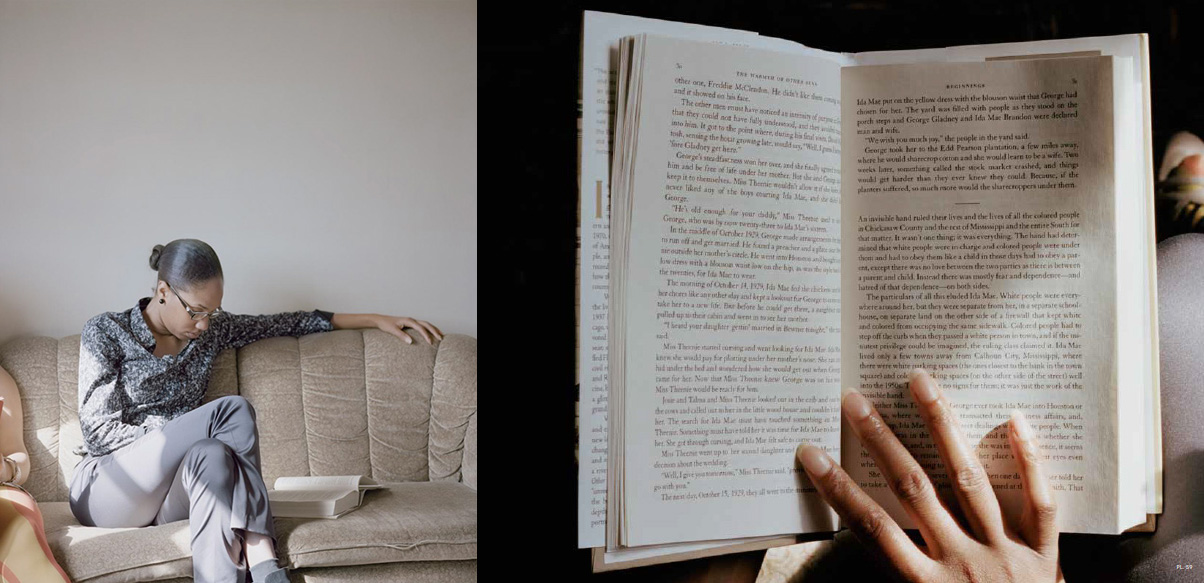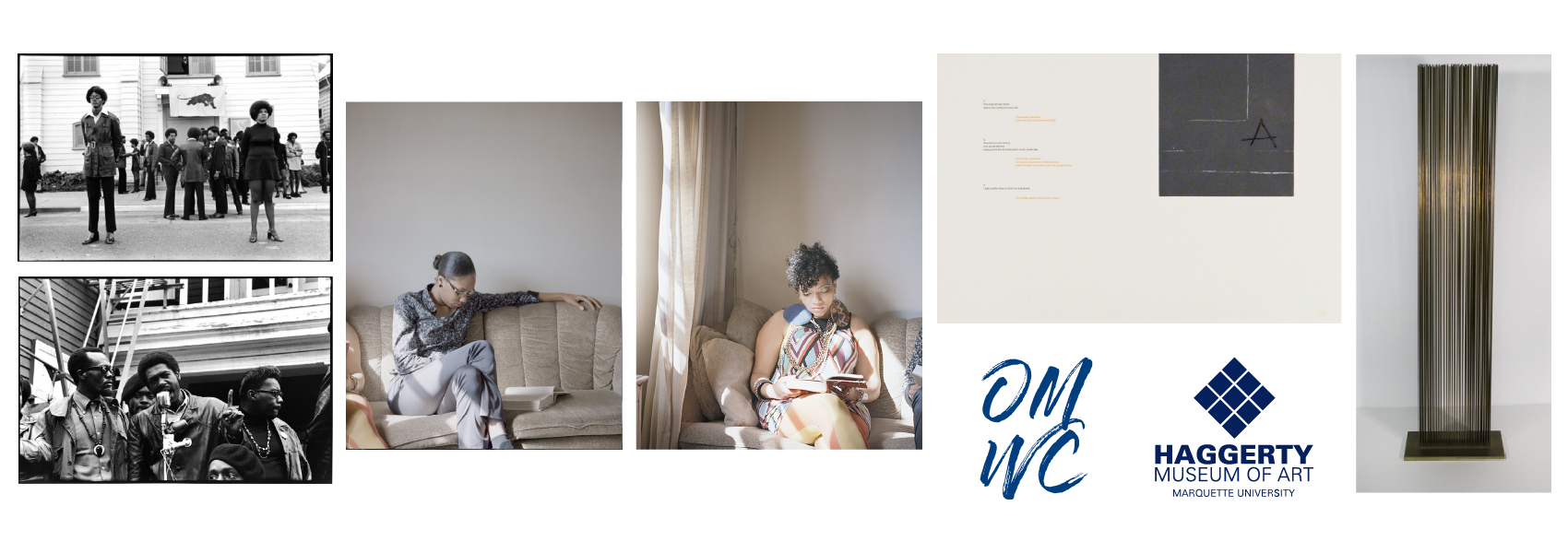March: Women's History Month
March is Women’s History Month, a time to recognize and celebrate women and their achievements. This year, in concert with Marquette’s March Mental Health Day, we invite you to join the reading women pictured below by artist Carrie Schneider. Spend time with their images. Reflect on women’s art, words, and work. Think about the former and current levels of female representation in publishing and literature, in film and media, in museums and the art historical canon, and in other cultural contexts. Imagine what those numbers will look like 10, 20, 30 years from now.

Both of these photos were taken by Brooklyn-based artist Carrie Schneider. For the series they belong to, Reading Women (2012-2014), Schneider photographed and filmed 100 female friends and colleagues while they were in their homes and studios reading works by women writers. The resulting photographs invite us to read these women and to read with them as they read the words of other women, including Angela Davis and Isabel Wilkerson.
Schneider’s pictures capture her sitters in states of deep concentration. She hoped to create honest portraits of women in which they lose awareness of the camera and any cultural pose/performance. Schneider and her work are informed by feminist theory, particularly criticism of the male gaze or the act of depicting women in the visual arts and in literature from a masculine perspective. Schneider wanted to photograph women not as objects to behold but as subjects with agency who are engaged and absorbed in activities of their choosing.
This pair of photographs is a diptych. Spend time looking at the two images together – what visual clues tell you that the sitters are in the same space (raking light from the window, same couch, cropped portions of each sitter’s body)? Why do you think the artist might have photographed them this way?
Looking Good, Marquette: Art & Writing for Mental Health
Post and tag your writing with #LookingGoodMarquette #BHM #HMA #OttWC
 Carrie Schneider, American, b. 1979, Abigail reading Angela Davis (An Autobiography, 1974) from the series Reading Women (2012–2014) C–print
Carrie Schneider, American, b. 1979, Abigail reading Angela Davis (An Autobiography, 1974) from the series Reading Women (2012–2014) C–print
Prompt 1 (5 minutes)
Look at the positioning of Schneider’s camera and the way that Abigail is framed (the camera is at eye level, the sitter frontal, occupying the lower right-hand corner of the picture). What feeling does the positioning and framing convey? How might you experience this picture differently if Schneider shot it from a different angle? What changes when you look at the photograph of Abigail’s hands and the book? What three details do you notice about that photograph (lighting, shadows, is the book old or new, where are her hands, what passages are legible and not?). Does seeing the photographs together change the way you experience this work?
Prompt 2 (5 minutes)
Imagine you are a dog sitting at Abigail’s feet while she reads or a bird outside the window. Set a timer for 5 minutes and describe what you see.
Prompt 3 (10 minutes)
Abigail is reading An Autobiography by Dr. Angela Davis, which was published in 1974, when Davis was only 30 years old. At that time, she was already a well-known activist. Two years earlier, she was acquitted for crimes that she did not commit. The pages Abigail is reading, which are shown in another one of Schneider’s photographs, includes this passage:
For those who enjoyed reading, the library would have been a saving grace had it not been for the fact that the vast majority of the books were mysteries, romances and just plain bad literature whose sole function was to create emotional paths of escape. During my days of solitary confinement, after Margaret had persuaded the warden that I should have access to reading material, I spent a few sessions alone in the library. Within a short time I had combed the entire place, turning up only a few books which held the slightest interest: A book on the Chinese Revolution by Edgar Snow, the autobiography of W. E. B. DuBois and a book on communism written by an astonishingly objective little-known author.
What 3 books (or kinds of books) have held your interest recently, offering you solace and company? Set a timer for 10 minutes and write about them. Describe what reading each one was like and what you gained from reading it.
 Carrie Schneider, American, b. 1979, LaToya reading Isabel Wilkerson (The Warmth of Other Suns: The Epic Story of America’s Great Migration, 2010) from the series Reading Women (2012–2014), C–print
Carrie Schneider, American, b. 1979, LaToya reading Isabel Wilkerson (The Warmth of Other Suns: The Epic Story of America’s Great Migration, 2010) from the series Reading Women (2012–2014), C–print
Prompt 4 (5 minutes)
Look at the positioning of Schneider’s camera and the way that LaToya is framed (the camera is at eye level, the sitter at the lower left-hand corner with her body turned and limbs drawing the eye to space outside the picture, there is blank space surrounding her). What changes when you look at the photograph of the book? What experience is that simulating? (seeing the pages from LaToya’s perspective). Does her hand placement draw your eye to specific passages in the text? What other details do you notice (Abigail’s foot is visible in the background)? Does this change the way you would read the portraits (as individual works vs. a dyptich)? Does seeing the images of each woman with the images of her book change the way you think about Schneider’s project as a whole?
Prompt 5 (10 minutes)
LaToya sits next to Abigail, reading Isabel Wilkerson’s epic first book, The Warmth of Other Suns, which tells the multi-generational story of the Great Migration 6 million southern Black Americans made northward across the US. Wilkerson conducted more than 1000 interviews, which form the basis of the nonfiction story she tells about Ida Mae Brandon Gladney, a sharecropper’s wife from Mississippi; George Swanson Starling, who left Florida for Harlem and civil rights activism; and Robert Joseph Pershing Foster, a Morehouse educated surgeon who became the personal physician to Ray Charles.
Pick one of the scenarios below, set a time, and write for 10 minutes about what happens next:
- The room is quiet except for the sound of pages occasionally turning. A delicious smell begins to waft through the room. The oven timer goes off, and LaToya looks up from her book and says to Abigail . . . .
- LaToya reads the same sentence for the fourth or maybe the fifth time: “An invisible hand ruled their lives and the lives of all the colored people in Chickasaw County and the rest of the Mississippi and the entire South for that matter.” But she can’t concentrate. Without turning, she says to Abigail . . . .
- LaToya is engrossed in Ida Mae’s story: “An invisible hand ruled their lives and the lives of all the colored people in Chickasaw County and the rest of”—. Then Abigail’s hand is on her arm, and she is saying something to her. “Wh-what?” she asks.
Prompt 6 (10 minutes)
Artist Carrie Schneider was also interested in exploring the constellations of intellectual influence represented by the archive of books selected by her Reading Women sitters. By yourself or with a group of friends, make a list of books by female authors that you would like to read. Or, select one of the books from the Reading Women list below and commit to reading it.
Expand all | Collapse all
List of books from Reading Women
- Abigail reading Angela Davis (An Autobiography, 1974);
- Alyssa reading Patti Smith (Just Kids, 2010);
- Amy reading Michelle Cliff (Abeng, 1984);
- Antonia reading Simone de Beauvoir (A Very Easy Death, 1964);
- Aura reading Maarit Verronen (Pimeästä Maasta, 1995);
- Bianca reading Sylvia Plath (Ariel, 1965);
- Brett reading Rebecca Solnit (Wanderlust: A History of Walking, 2001);
- Cauleen reading Gwendolyn Brooks (Blacks, pub. 2008);
- Cecilia reading Alejandra Pizarnik (Poesía Completa, pub. 2000);
- Christine reading Ruth Wilson Gilmore (Golden Gulag: Prisons, Surplus, Crisis, And Opposition in Globalizing California, 2007);
- Claire reading Laura Mullen (Was O, 2012);
- Claire reading Lauren Berlant (Cruel Optimism, 2011);
- Corinne reading Marilynne Robinson (Housekeeping, 1980);
- Courey reading Flannery O'Connor (The Complete Stories, pub. 1971);
- Dana reading Virginia Woolf (To the Lighthouse, 1927);
- Deirdre reading Patricia Highsmith (Little Tales of Misogyny, 1974);
- Diana reading Anne Carson (Autobiography of Red, 1999);
- Drea reading Jane Austen (Pride and Prejudice, 1813);
- Elizabeth reading Lucy Lippard (The Lure of the Local: Senses of Place in a Multicentered Society, 1998);
- Evan reading Anne Lamott (Traveling Mercies, 2000);
- Flávia reading Clarice Lispector (Clarice na Cabeceira, pub. 2009);
- Francesca reading Rachel Haidu (The Absence of Work: Marcel Broodthaers, 1964-1976, 2010);
- Guille reading Silvina Ocampo (Cuentos Completos I, 1999);
- Heather reading Chris Kraus (Summer of Hate, 2012);
- Holly reading Arundhati Roy (God of Small Things, 1997);
- Hsiao-Jou reading Fang-Yi Sheu (Life Attitude: I'm Not Afraid to be Different, 2007);
- Jessie reading Téa Obreht (The Tiger's Wife, 2011);
- Juliana reading Pamela Des Barres (I'm with the Band: Confessions of a Groupie, 1987);
- Juliana reading Louisa May Alcott (Little Women, 1868-69);
- Julie reading Mary Oliver (The Leaf and the Cloud: A Poem, 2001);
- Karen reading Joyce Carol Oates (I Am No One You Know: Stories, 2004);
- Karine reading Marie Darrieussecq (Il faut beaucoup aimer les hommes, 2013);
- Katherine reading Luce Irigaray (Marine Lover of Friedrich Nietzsche, 1980);
- Katie reading Moyra Davey (Mother Reader, 2001);
- Katie reading Harper Lee (To Kill a Mockingbird, 1960);
- Kelly reading Gabrielle Hamilton (Blood, Bones & Butter: The Inadvertent Education of a Reluctant Chef, 2011);
- Kim reading Rebecca Solnit (A Field Guide to Getting Lost, 2005);
- Kira reading Mary Shelley (Frankenstein, 1818);
- LaToya reading Isabel Wilkerson (The Warmth of Other Suns: The Epic Story of America's Great Migration, 2010);
- Laura reading Enheduanna (Inanna, Lady of Largest Heart: Poems of the Sumerian High Priestess (2300 BCE, pub. 2001);
- Luciana reading Marosa di Giorgio (Rosa Mistica: Relatos Eroticos, 2003);
- Maria reading Antonia Palacios (Ana Isabel, Una Niña Decente, 1949);
- Marie reading Jette A. Kaarsbøl (Den Lukkede Bog, 2003);
- Marjolaine reading Virginie Despentes (Apocalypse bébé, 2010);
- Megha reading Edith Wharton (The House of Mirth, 1905);
- Melissa reading Tove Jansson (A Winter Book, 1968-1996, pub. 2006);
- Michelle reading Agatha Christie (Dumb Witness (Poirot Loses a Client),1937);
- Michelle reading Betty Smith (A Tree Grows in Brooklyn, 1943);
- Molly reading Roseanne Barr (My Lives, 1994)
- Molly reading Fanny Howe (The Winter Sun: Notes on a Vocation, 2009);
- Naomi reading Adrian Piper (Out of Order, Out of Sight, Vol. I: Selected Writings in Meta-Art 1968-1992, pub. 1999);
- Nuiko reading Henriette Renié (Trio for Harp, Violin and Cello, 1910);
- Peggy reading MFK Fisher (The Art of Eating, 1954);
- Phyllis reading Maya Angelou (Letter to My Daughter, 2008);
- Rachel reading Joan Didion (Democracy, 1984);
- Rebecca reading Joy Williams (State of Grace, 1974);
- Rebekah reading Sofia Gubaidulina (Concerto for Bassoon and Low Strings, 1975);
- Rena reading Zadie Smith (White Teeth, 2000);
- Sara reading Oriana Fallaci (A Man, 1979);
- Sara reading Miranda July (No One Belongs Here More Than You: Stories, 2008);
- Sarah reading Gail Scott (My Paris, 1999);
- Sarah reading Zora Neale Hurston (Every Tongue Got to Confess: Negro Folk-Tales from the Gulf States, 2001);
- Shannon reading Aritha Van Herk (No Fixed Address, 1998);
- Sheree reading Angela Carter (Nights at the Circus, 1984);
- Sofia reading Marguerite Duras (L'Amour, 1971);
- Tiffany reading Ying-Tai Lung (Big River, Big Sea - Untold Stories of 1949, 2009);
- Val reading Catherine Malabou (Changing Difference, 2009);
- Vanessa reading Nathalie Sarraute (Portrait d'un Inconnu, 1948)
- Vicky reading Gloria Fuertes (Historia de Gloria: Amor, Humor and Desamor (Letras Hispanicas), 1983);
- Whitney reading Terry Tempest Williams (When Women Were Birds: Fifty-four Variations on Voice, 2012);
- Yala reading Susan Sontag (The Volcano Lover, 1992)




 Carrie Schneider, American, b. 1979, Abigail reading Angela Davis (An Autobiography, 1974) from the series Reading Women (2012–2014) C–print
Carrie Schneider, American, b. 1979, Abigail reading Angela Davis (An Autobiography, 1974) from the series Reading Women (2012–2014) C–print Carrie Schneider, American, b. 1979, LaToya reading Isabel Wilkerson (The Warmth of Other Suns: The Epic Story of America’s Great Migration, 2010) from the series Reading Women (2012–2014), C–print
Carrie Schneider, American, b. 1979, LaToya reading Isabel Wilkerson (The Warmth of Other Suns: The Epic Story of America’s Great Migration, 2010) from the series Reading Women (2012–2014), C–print